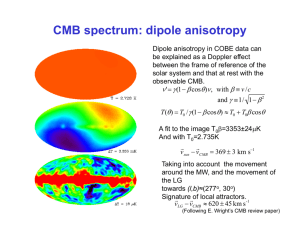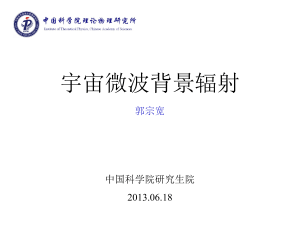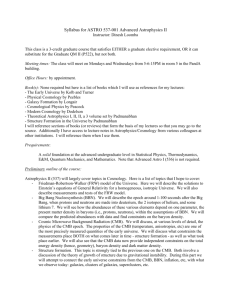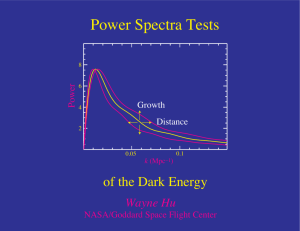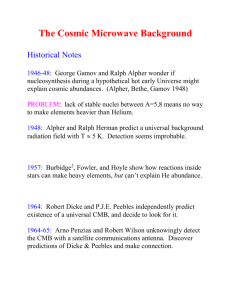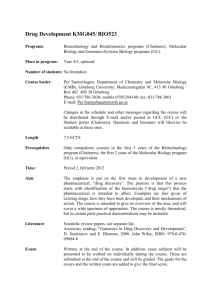V. The Thermal Beginning
advertisement
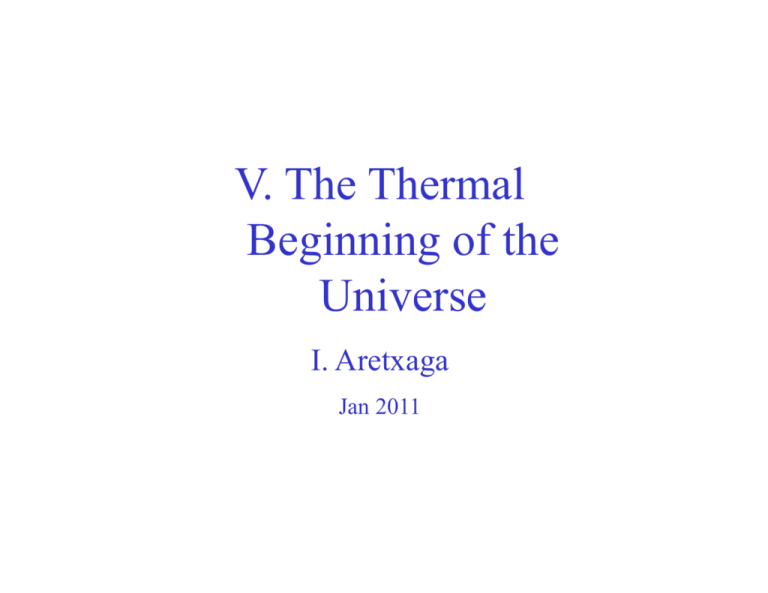
V. The Thermal Beginning of the Universe I. Aretxaga Jan 2011 CMB discovery time-line -1947-1948 Gamow, Alpher and Hermans model of nucleosynthesis predicts relic millimeter radiation, but the models have difficulties to produce elements heavier than Li, leads to its neglect. -1965 Arno Penzias & Robert Wilson’s serendipitous discovery of a constant excess isotropic noise with their antenna at Bell Labs (Nobel 1978). -late 60’s many groups made measurements of the intensity of the radiation and a temperature collectively showing the spectrum is that of a BB (to 10% accuracy) -1969 Tentative detection of a dipole anisotropy by Conklin, confirmed in 1971-1977 by Henry, Wilkinson, and Smooth et al. -1989 COBE (COsmic Background Explorer) launched, in 1990 first results confirming BB spectrum. -1992 COBE’s detection of non-dipole anisotropies (nobel prize 2006 for PI’s Smoot & Mather. -2003 WMAP results on precission cosmology through CMB anisotropies, end mission 2010 (Following E. Wright’s CMB review paper) Dominant background radiation GTM The photons of the CMB are still the largest contributors to the radiation energy in the Universe. CMB spectrum An almost perfect BB was measured by the FIRAS instrument aboard COBE when it was compared to a very good BB calibrator. T=2.725±0.002 K (E. Wright) (Following E. Wright’s (From CMB M.review Plionis’paper) notes) CMB spectrum a ≡ 4σ /c = 7.565 ×10−16 Jm-3K −4 a scale factor (From M. Georganopoulos’ lecture lib) CMB spectrum: z evolution (From M. Georganopoulos’ lecture lib) CMB spectrum: z evolution The almost perfect BB shape of the CMB backs up the expansion of the Universe, and the existence of a hotter earlier universe. If the CMB were just a tired relic light: Iγ(z=0)=(1+ze)3Bν(Te) but FIRAS imposes that the factor in front of Bν(Te) is 1 with a precission better than 10-4. Hence (1+ze)=1±1x10-4 ⇒ ze<0.000033 and opaque from that onwards. But we have sources at z~4! So this is not a possibility. If the steady model were correct, there would be no evolution. Today we see CMB + FIR radiation from stars and galaxies. Energy added between 1 month and a few thousand yrs after BB will produce 2πν 3 1 IBE (ν ,T) = 2 c exp(hν /kT + µ) −1 but there are no deviations to the BB spectrum (Following E. Wright’s CMB review paper) Photon/baryon ratio (From M. Georganopoulos’ lecture lib) Photon/baryon ratio ΩB /Ωγ ≈ 1000 , nγ /n B ≈ 10 9 (From M. Georganopoulos’ lecture lib) Radiation era We have that ρM∝R-3 ρrad∝R-4 There must be a z at which ρM= ρrad Taking into account that nucleosynthesis predicts nν=0.68 nγ , then Ωrad=4.2 x 10-5 h-2 1 + zeq = 23900Ωm h 2 ⇒ zeq ≈ 3100 (From M. Plionis’ notes or Peacock 1999) CMB origin (From M. Georganopoulos’ lecture lib) CMB origin (From M. Georganopoulos’ lecture lib) CMB origin (From M. Georganopoulos’ lecture lib) CMB origin: recombination 1200 1300 1400 1500 X ≡ ne /nB = n e /(n H + n p ) (From M. Georganopoulos’ lecture lib) CMB origin: decoupling (From M. Georganopoulos’ lecture lib) CMB origin: decoupling Time (yr) 47000 256000 372000 372000 (From M. Georganopoulos’ lecture lib) CMB spectrum: dipole anisotropy Dipole anisotropy in COBE data can be explained as a Doppler effect between the frame of reference of the solar system and that at rest with the observable CMB. ν '= γ (1− β cosθ )ν , with β ≡ v /c and γ ≡ 1/ 1− β 2 T(θ ) = T0 / γ (1− β cosθ ) ≈ T0 + T0β cosθ A fit to the image T0β=3353±24µK And with T0=2.735K r r v sun − vCMB = 369 ± 3 km s−1 Taking into account the movement around the MW, and the movement of the LG towards (l,b)≈(277o, 30o) Signature r rof local attractors.-1 vLG − vCMB ≈ 620 ± 45 km s (Following E. Wright’s CMB review paper) CMB spectrum: removing the galaxy WMAP: 23 to 90 GHz image of the CMB after dipole subtraction. The galaxy emission is dominated by dust CMB spectrum: removing the galaxy Cosmic Background Explorer COBE (1992): ∆T/T = 10−5 CMB spectrum: removing the galaxy WMAP full sky view Graphics from WMAP website CMB spectrum: statistical properties T(l,b) can be fully specified by either the angular correlation function C(θ) or its Legendre transformation, the angular power spectrum Cl. 1 C(θ ) = ∑ (2l + 1)Cl Pl (cosθ) where Pl are Legendre Which are related by 4π l polynomials of order l. A term Cl is a measure of angular fluctuations on the angular scale θ~180o/l. In order to have equal power for all scales the spherical harmonics impose Cl = cte/l(l+1).If the sky had equal power on all scales lCl(l+1)Graphics should be a constant. from WMAP website CMB spectrum: power spectrum Graphics from WMAP website (From M. Georganopoulos’ lecture lib) CMB spectrum: power spectrum l First peak had already been constrained by an array of 1992-2000 missions, and sampled in its full amplitude by Boomerang (1998) & Maxima (2000) Graphics(Hu from WMAP2002) website & Dodelson CMB spectrum: power spectrum Graphics(From fromHu’s WMAP website webpage) CMB spectrum: power spectrum Graphics from WMAP website (From M. Georganopoulos’ lecture lib) CMB spectrum: power spectrum Graphics from WMAP website (From M. Georganopoulos’ lecture lib) CMB spectrum: power spectrum θ>θ θH Graphics from WMAP website (From M. Georganopoulos’ lecture lib) CMB spectrum: power spectrum θ<θ θH Graphic by Wayne Hu, http://background.uchicago.edu/~whu/beginners/introduction.html Graphics from WMAP website (From M. Georganopoulos’ lecture lib) CMB spectrum: 1st peak of power spectrum Graphics from WMAP website (From M. Georganopoulos’ lecture lib) CMB spectrum: 1st peak of power spectrum Graphics from WMAP website (From M. Georganopoulos’ lecture lib) CMB spectrum: cosmic dependences Varied around a fidutial model Ωtot=1, ΩΛ=0.65, ΩB=0.02h-2, Ωm=0.147h-2, n=1, zri=0, E=0 Graphics from WMAP website (Hu & Dodelson 2002)
